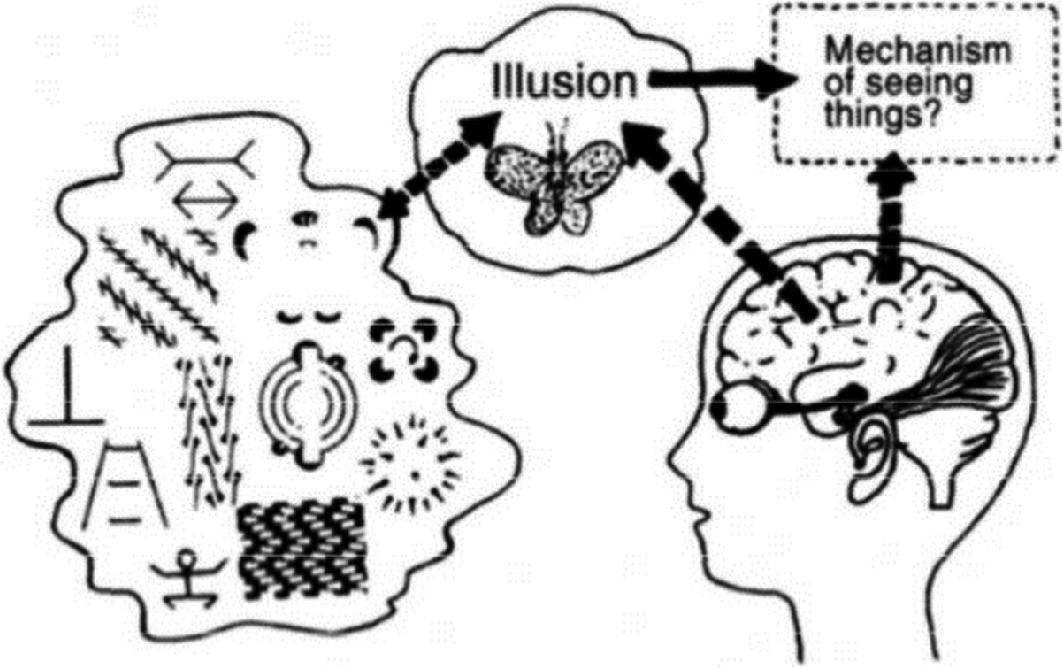- Favorite eBook Reading The User Illusion Cutting Consciousness Down To Size Penguin Press Science S TEXT #1: Introduction The User Illusion Cutting Consciousness Down To Size Penguin Press Science S By Barbara Cartland - Jul 19, 2020 Last Version The User Illusion Cutting Consciousness Down To.
- He is the author of The User Illusion. Millions of eBooks to Read Instantly. Become a B&N Member. Members Save Every Day.
Includes bibliographical references (p. 445-456) and index. Access-restricted-item true Addeddate 2011-04-06 22:02:30 Boxid IA138413 Camera.

The user illusion is the illusion created for the user by a human–computer interface, for example the visual metaphor of a desktop used in many graphical user interfaces. The phrase originated at Xerox PARC.[1]
Some philosophers of mind have argued that consciousness is a form of user illusion. This notion is explored by Tor Nørretranders in his 1991 Danish book Mærk verden, issued in a 1998 English edition as The User Illusion: Cutting Consciousness Down to Size.[2] He introduced the idea of exformation in this book. Philosopher Daniel Dennett has also embraced the view that human consciousness is a 'user-illusion'.[3]
According to this picture, our experience of the world is not immediate, as all sensation requires processing time. It follows that our conscious experience is less a perfect reflection of what is occurring, and more a simulation produced unconsciously by the brain. Therefore, there may be phenomena that exist beyond our peripheries, beyond what consciousness could create to isolate or reduce them.
Criticism[edit]
Critics of the idea of consciousness being a device for justifying preconceptions argue that such a device would consume nutrients without producing any useful results, since it would not change the outcome of any decisions. These critics argue that the existence of social insects with extremely small brains falsifies the notion that social behavior requires consciousness, citing that insects have too small brains to be conscious and yet there are observed behaviors among them that for all functional intents and purposes match those of complex social cooperation and manipulation (including hierarchies where each individual has its place among paper wasps and Jack Jumperants and honey bees sneaking when they lay eggs). These critics also argue that since social behavior in insects and other extremely small-brained animals have evolved multiple times independently, there is no evolutionary difficulty in simple reaction sociality to impose selection pressure for the more nutrient-consuming path of consciousness for sociality. These critics do point out that other evolutionary paths to consciousness are possible, such as critical evaluation that enhances plasticity by criticizing fallible notions, while pointing out that such a critical consciousness would be quite different from the justificatory type proposed by Nørretranders, differences including that a critical consciousness would make individuals more capable of changing their minds instead of justifying and persuading.[4][5]
See also[edit]
- Anil Seth, who espouses a similar notion of experienced reality as a hallucination
References[edit]
- ^Bruce Tognazzini (1996). Tog on Software Design. Addison-Wesley Professional. ISBN0-201-48917-1.
- ^Tor Nørretranders (1998). The User Illusion: Cutting Consciousness Down to Size. Viking. ISBN0-670-87579-1.
- ^'Human consciousness is unlike all other varieties of animal consciousness in that it is a product in large part of cultural evolution ... creating thereby a cognitive architecture unlike the 'bottom-up' minds of animals.... [T]his architecture furnishes each of us with ... a user-illusion' (Daniel C. Dennett, From Bacteria to Bach and Back: The Evolution of Minds (2017), p. 370).
- ^How the body shapes the way we think: A new view of intelligence, Rolf Pfeifer, Josh Bongard
- ^Information Processing in Social Insects: Claire Detrain, Jean L. Deneubourg, Jacques M. Pasteels
 In The User Illusion: Cutting Consciousness Down To Size (Penguin Books, 1991, English translation 1998), Danish science writer Tor Norretranders dissects the powerful illusion that humans believe that what they see and think is real. The User Illusion (TUI) relentlessly describes human consciousness and the false reality that we believe is real. TUI is about the constraints on knowledge. The 2nd law of thermodynamics and the curse of always increasing disorder (entropy), information theory and mathematics all make it undisputable that everything sentient in the universe operates under severe constraints. That includes all forms of life and the limits on the human mind. To believe otherwise is a mistake, or more accurately, an illusion.
In The User Illusion: Cutting Consciousness Down To Size (Penguin Books, 1991, English translation 1998), Danish science writer Tor Norretranders dissects the powerful illusion that humans believe that what they see and think is real. The User Illusion (TUI) relentlessly describes human consciousness and the false reality that we believe is real. TUI is about the constraints on knowledge. The 2nd law of thermodynamics and the curse of always increasing disorder (entropy), information theory and mathematics all make it undisputable that everything sentient in the universe operates under severe constraints. That includes all forms of life and the limits on the human mind. To believe otherwise is a mistake, or more accurately, an illusion.TUI’s chapter 6, The Bandwidth of Consciousness, gets right to the heart of matters. Going there is an enlightening but humbling experience. When awake, the information flow from human sensory nerves to the brain is about 11.2 million bits per second, with the eyes bringing in about 10 million bits per second, the skin about 1 million bits per second, with the ears and nose each bringing in about 100,000 thousand bits per second. That’s a lot, right? No, it isn’t. The real world operates at unknowable trillions of gigabits/second, so what we see or perceive isn’t much. It’s puny, actually.
But, remember, we needed only enough capacity to survive, not to know the future 10 or 100 years in advance or to see a color we can’t see using eyes with just three different color sensing cell types. For human survival, three colors was good enough. Evidence of evolutionary success is a planet population of 7 billion humans that’s rapidly heading toward 8 billion.
Although that 11.2 million bits/second may sound feeble, things are much, much weirder than just that. The 11.2 million bits/second are flowing into our unconscious minds. We are not conscious of all of that. So, what is the bandwidth of consciousness? How much of the 11.2 million bits/second we sense do we become aware of? The answer is an even more humbling 1-50 bits/second. At least, that’s the estimated rate at which human consciousness processes the information it is aware of. Silently reading this discussion consumes about 45 bits/second, reading aloud consumes about 30 bits/second, multiplying and adding two numbers consumes about 12 bits/second, counting objects consumes about 3 bits/second and distinguishing between different degrees of taste sweetness consumes about 1 bit/second.
What’s going on here??: It’s fair to ask what's really going on and why does our brain operate this way. The answer to the last question is that (i) it’s all that was needed to survive, and (ii) the laws of nature and the nature of biological organisms like humans are simply limited in what they can do. The human brain is large relative to body size but nonetheless only it processes information at a maximum rate of about 11.2 million bits/second because that’s what evolution conferred.
The more interesting question is what’s going on? What’s going on is that our unconscious mind takes in information at about 11.2 million bits/second, discards what’s not important or needed, which is about 11.2 million bits/second minus about 50 bits/second and then presents the little trickle of important information to consciousness. That’s how much bandwidth humans need, e.g., for finagling sex, spotting and running away from a hungry saber tooth cat before being eaten, finding or hunting food, or whatever was needed to survive.
Where things get very, very strange is in the presentation of the little trickle to consciousness. Discussing that step is a different discussion, but a glimpse of it as applied to politics is in the Democracy for Realists book review. This discussion focuses on the human brain operating system and the inputs and outputs it deals with and creates.
The User Illusion Ebooks
If one accepts the veracity of the science and Norretrander’s narrative, it is fair to say that the world that humans think they see is more illusion than real. Other chapters of TUI and the science behind the observations reinforce this reality of human cognition and its limits. For example, chapter 9,The User Illusion Book
The Half-Second Delay, describes how our unconscious minds make decisions about 0.5 second before we become aware of what it is we have unconsciously decided. Despite that, we consciously believe that we made a decision about 0.5 second before we became aware of it. We trick ourselves.The User Illusion Book
 In other words, we operate under an illusion that our conscious minds is making decisions when in fact that is the rare exception. The rule is that our unconscious minds are calling the shots most of the time. When it comes to perceiving reality, the low-bandwidth signal the brain uses to create a picture is a simulation that we routinely mistake for reality. As Norretranders sees it, consciousness is a fraud. That’s the user illusion.
In other words, we operate under an illusion that our conscious minds is making decisions when in fact that is the rare exception. The rule is that our unconscious minds are calling the shots most of the time. When it comes to perceiving reality, the low-bandwidth signal the brain uses to create a picture is a simulation that we routinely mistake for reality. As Norretranders sees it, consciousness is a fraud. That’s the user illusion.B&B orig: 8/20/16
